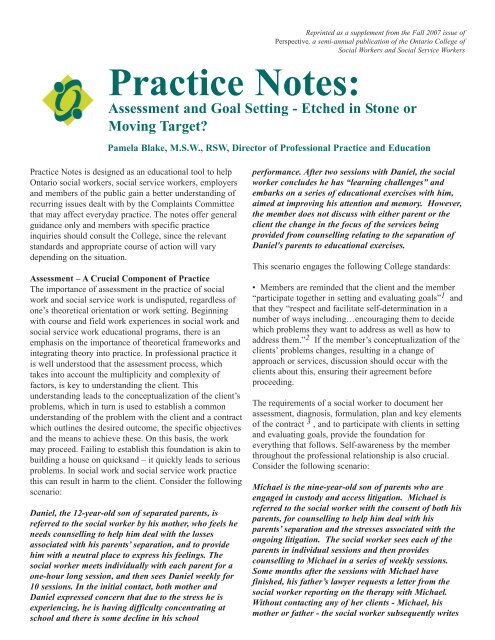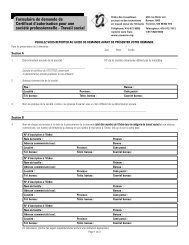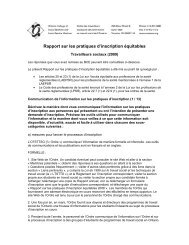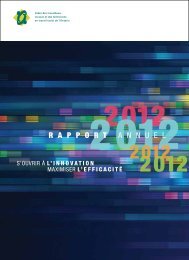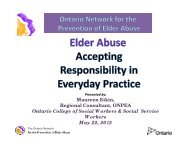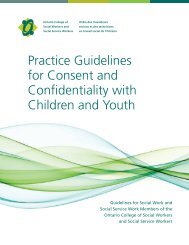Assessment and Goal Setting - Ontario College of Social Workers ...
Assessment and Goal Setting - Ontario College of Social Workers ...
Assessment and Goal Setting - Ontario College of Social Workers ...
You also want an ePaper? Increase the reach of your titles
YUMPU automatically turns print PDFs into web optimized ePapers that Google loves.
Reprinted as a supplement from the Fall 2007 issue <strong>of</strong><br />
Perspective, a semi-annual publication <strong>of</strong> the <strong>Ontario</strong> <strong>College</strong> <strong>of</strong><br />
<strong>Social</strong> <strong>Workers</strong> <strong>and</strong> <strong>Social</strong> Service <strong>Workers</strong><br />
Practice Notes:<br />
<strong>Assessment</strong> <strong>and</strong> <strong>Goal</strong> <strong>Setting</strong> - Etched in Stone or<br />
Moving Target?<br />
Pamela Blake, M.S.W., RSW, Director <strong>of</strong> Pr<strong>of</strong>essional Practice <strong>and</strong> Education<br />
Practice Notes is designed as an educational tool to help<br />
<strong>Ontario</strong> social workers, social service workers, employers<br />
<strong>and</strong> members <strong>of</strong> the public gain a better underst<strong>and</strong>ing <strong>of</strong><br />
recurring issues dealt with by the Complaints Committee<br />
that may affect everyday practice. The notes <strong>of</strong>fer general<br />
guidance only <strong>and</strong> members with specific practice<br />
inquiries should consult the <strong>College</strong>, since the relevant<br />
st<strong>and</strong>ards <strong>and</strong> appropriate course <strong>of</strong> action will vary<br />
depending on the situation.<br />
<strong>Assessment</strong> – A Crucial Component <strong>of</strong> Practice<br />
The importance <strong>of</strong> assessment in the practice <strong>of</strong> social<br />
work <strong>and</strong> social service work is undisputed, regardless <strong>of</strong><br />
one’s theoretical orientation or work setting. Beginning<br />
with course <strong>and</strong> field work experiences in social work <strong>and</strong><br />
social service work educational programs, there is an<br />
emphasis on the importance <strong>of</strong> theoretical frameworks <strong>and</strong><br />
integrating theory into practice. In pr<strong>of</strong>essional practice it<br />
is well understood that the assessment process, which<br />
takes into account the multiplicity <strong>and</strong> complexity <strong>of</strong><br />
factors, is key to underst<strong>and</strong>ing the client. This<br />
underst<strong>and</strong>ing leads to the conceptualization <strong>of</strong> the client’s<br />
problems, which in turn is used to establish a common<br />
underst<strong>and</strong>ing <strong>of</strong> the problem with the client <strong>and</strong> a contract<br />
which outlines the desired outcome, the specific objectives<br />
<strong>and</strong> the means to achieve these. On this basis, the work<br />
may proceed. Failing to establish this foundation is akin to<br />
building a house on quicks<strong>and</strong> – it quickly leads to serious<br />
problems. In social work <strong>and</strong> social service work practice<br />
this can result in harm to the client. Consider the following<br />
scenario:<br />
Daniel, the 12-year-old son <strong>of</strong> separated parents, is<br />
referred to the social worker by his mother, who feels he<br />
needs counselling to help him deal with the losses<br />
associated with his parents’ separation, <strong>and</strong> to provide<br />
him with a neutral place to express his feelings. The<br />
social worker meets individually with each parent for a<br />
one-hour long session, <strong>and</strong> then sees Daniel weekly for<br />
10 sessions. In the initial contact, both mother <strong>and</strong><br />
Daniel expressed concern that due to the stress he is<br />
experiencing, he is having difficulty concentrating at<br />
school <strong>and</strong> there is some decline in his school<br />
performance. After two sessions with Daniel, the social<br />
worker concludes he has “learning challenges” <strong>and</strong><br />
embarks on a series <strong>of</strong> educational exercises with him,<br />
aimed at improving his attention <strong>and</strong> memory. However,<br />
the member does not discuss with either parent or the<br />
client the change in the focus <strong>of</strong> the services being<br />
provided from counselling relating to the separation <strong>of</strong><br />
Daniel's parents to educational exercises.<br />
This scenario engages the following <strong>College</strong> st<strong>and</strong>ards:<br />
• Members are reminded that the client <strong>and</strong> the member<br />
“participate together in setting <strong>and</strong> evaluating goals” 1 <strong>and</strong><br />
that they “respect <strong>and</strong> facilitate self-determination in a<br />
number <strong>of</strong> ways including…encouraging them to decide<br />
which problems they want to address as well as how to<br />
address them.” 2 If the member’s conceptualization <strong>of</strong> the<br />
clients’ problems changes, resulting in a change <strong>of</strong><br />
approach or services, discussion should occur with the<br />
clients about this, ensuring their agreement before<br />
proceeding.<br />
The requirements <strong>of</strong> a social worker to document her<br />
assessment, diagnosis, formulation, plan <strong>and</strong> key elements<br />
<strong>of</strong> the contract 3 , <strong>and</strong> to participate with clients in setting<br />
<strong>and</strong> evaluating goals, provide the foundation for<br />
everything that follows. Self-awareness by the member<br />
throughout the pr<strong>of</strong>essional relationship is also crucial.<br />
Consider the following scenario:<br />
Michael is the nine-year-old son <strong>of</strong> parents who are<br />
engaged in custody <strong>and</strong> access litigation. Michael is<br />
referred to the social worker with the consent <strong>of</strong> both his<br />
parents, for counselling to help him deal with his<br />
parents’ separation <strong>and</strong> the stresses associated with the<br />
ongoing litigation. The social worker sees each <strong>of</strong> the<br />
parents in individual sessions <strong>and</strong> then provides<br />
counselling to Michael in a series <strong>of</strong> weekly sessions.<br />
Some months after the sessions with Michael have<br />
finished, his father’s lawyer requests a letter from the<br />
social worker reporting on the therapy with Michael.<br />
Without contacting any <strong>of</strong> her clients - Michael, his<br />
mother or father - the social worker subsequently writes
the letter, containing her opinions <strong>and</strong> conclusions which<br />
are supportive <strong>of</strong> the father. The nature <strong>of</strong> the social<br />
worker’s opinions reflected those usually seen in custody<br />
<strong>and</strong> access reports, though the stated purpose <strong>of</strong> contact<br />
was to provide counselling to assist Michael's coping<br />
with his parent’s high conflict separation, <strong>and</strong> the social<br />
worker’s contact with the parents had been minimal.<br />
The above scenario raises a number <strong>of</strong> issues <strong>and</strong> engages<br />
the following <strong>College</strong> st<strong>and</strong>ards:<br />
• The issue <strong>of</strong> whether to release clients’ information to a<br />
third party must be carefully examined: “Prior to releasing<br />
information from a record that pertains to more than one<br />
client, for example, a couple, family group…<strong>College</strong><br />
members receive authorization from each individual<br />
client.” 4 Additionally, “<strong>College</strong> members inform clients<br />
<strong>of</strong> the parameters <strong>of</strong> information to be disclosed <strong>and</strong> make<br />
reasonable efforts to advise clients <strong>of</strong> the possible<br />
consequences <strong>of</strong> such disclosure.” 5 Even with consent, a<br />
member may feel that releasing information is ill advised,<br />
for example in the context <strong>of</strong> acrimonious court<br />
proceedings, <strong>and</strong> should take steps to convey this concern<br />
to the client.<br />
• In providing information about clients to a third party<br />
“<strong>College</strong> members do not make statements…or issue or<br />
sign a certificate, report or other document…that the<br />
member knows or ought reasonably to know are false,<br />
misleading, inaccurate or otherwise improper.” 6 A<br />
document provided by a member should therefore focus on<br />
the nature <strong>of</strong> the member’s contact with the client <strong>and</strong> not<br />
venture opinions about issues that have not been addressed<br />
in the services provided.<br />
• High conflict situations are emotionally charged for all<br />
parties, <strong>and</strong> members are not immune. Members must be<br />
“aware <strong>of</strong> their values, attitudes <strong>and</strong> needs <strong>and</strong> how these<br />
impact on their pr<strong>of</strong>essional relationships with clients.” 7<br />
The record should: “report impartially <strong>and</strong> objectively the<br />
factors relevant to the client's situation. The record clearly<br />
distinguishes the <strong>College</strong> member's observations <strong>and</strong><br />
opinions from the information reported by the client”. 8<br />
The record should also “be free <strong>of</strong> prejudice <strong>and</strong><br />
discriminatory remarks”. 9<br />
Had the social worker in the previous scenario<br />
demonstrated this personal, clinical <strong>and</strong> contractual clarity<br />
it would have contributed greatly to a focus in her practice<br />
<strong>and</strong> helped her avoid straying into dangerous waters that<br />
were not in her clients’ best interest.<br />
Revisiting <strong>Goal</strong>s<br />
While it is crucial to maintain focus on the agreed upon<br />
goals that flowed from the initial assessment, assessment is<br />
ongoing <strong>and</strong> goals can be revisited. Consider the<br />
following:<br />
Maria, a newly separated mother <strong>of</strong> three children, seeks<br />
counselling to help her deal with her recent job loss <strong>and</strong><br />
home stress. The agency she contacts <strong>of</strong>fers up to six<br />
sessions <strong>and</strong> this is explained to her at the outset. The<br />
goals that she <strong>and</strong> the member agree upon are therefore<br />
modest, in keeping with the time-limited nature <strong>of</strong> the<br />
services available to her. She <strong>and</strong> the member agree that<br />
the ultimate goal will be to link her to other resources<br />
that would provide the ongoing assistance she requires.<br />
After the third session, however, Maria calls the member<br />
to inform her that her children have been apprehended<br />
by child welfare. Underst<strong>and</strong>ably distressed, she asks the<br />
member to contact the child welfare worker <strong>and</strong> the<br />
member agrees. The member <strong>and</strong> Maria then decide<br />
together that their immediate goal will be to determine<br />
what Maria needs to do in order to have her children<br />
returned to her. The member advocates with her<br />
employer on Maria’s behalf to extend their contract for<br />
two additional sessions <strong>and</strong> is successful in this. Maria<br />
<strong>and</strong> the member deal with the urgent child welfare issues<br />
<strong>and</strong> Maria is linked to resources that will provide<br />
ongoing support for her personal <strong>and</strong> family issues <strong>and</strong><br />
assistance in finding employment.<br />
In this situation the member was aware <strong>of</strong> the “purpose,<br />
m<strong>and</strong>ate <strong>and</strong> function” <strong>of</strong> her employing organization, <strong>and</strong><br />
“how these impact on <strong>and</strong> limit pr<strong>of</strong>essional relationships<br />
with clients” 10 <strong>and</strong> was mindful <strong>of</strong> this in her initial<br />
contract, though when a crisis arose, was able to<br />
renegotiate with the client to focus on the immediate issue<br />
<strong>of</strong> the apprehension <strong>of</strong> her children. The member also<br />
appropriately advocated on behalf <strong>of</strong> her client 11 <strong>and</strong> was<br />
able to extend the sessions to allow her <strong>and</strong> her client to<br />
return to their original contract.<br />
As already established, client participation in setting goals<br />
is pivotal. This is more difficult, however, when the client<br />
is a family <strong>and</strong> more particularly, a family fraught with<br />
conflict whose members may agree on very little. This<br />
challenge is compounded when the goal for intervention is<br />
imposed by an external body:<br />
Jill, a 14-year-old girl who lives with her mother <strong>and</strong><br />
stepfather, has no contact with her biological father. He<br />
has gone to court to have his access reinstated. The<br />
Judge orders reconciliation counselling <strong>and</strong> the social<br />
worker is retained. She meets with Jill for 12 sessions,<br />
<strong>and</strong> during sessions, Jill consistently expresses that she<br />
does not want contact with her father. With Jill’s consent<br />
the social worker conveys Jill’s stance to both parents<br />
<strong>and</strong> legal counsel for each <strong>of</strong> the parties, including Jill.<br />
She recommends that Jill be encouraged by her mother<br />
<strong>and</strong> stepfather to participate in counselling <strong>and</strong> that they,<br />
as well as her biological father, also engage in<br />
counselling about how best to assist Jill in reestablishing<br />
contact with her father.
Jill continues to state to the social worker that she does<br />
not want contact with her father, nor does she wish to<br />
continue the counselling. Jill’s mother <strong>and</strong> stepfather<br />
state that they will not insist that Jill attend counselling.<br />
Clearly, although there was initial agreement, there is not a<br />
consensus about the contract <strong>and</strong> the goal will not be met.<br />
The social worker decided to revisit with all parties the<br />
stated goals <strong>of</strong> their work together <strong>and</strong> to reevaluate them<br />
to determine whether the work can continue.<br />
Are assessment <strong>and</strong> setting goals etched in stone or a<br />
moving target? Neither. What is required is initial<br />
assessment <strong>and</strong> conceptualization <strong>of</strong> the problems,<br />
collaborative goal definition <strong>and</strong> agreement about the key<br />
elements <strong>of</strong> the contract. This solid foundation will<br />
provide a focus <strong>and</strong> clarity for the ensuing work. Members<br />
must also be alert to their own reactions <strong>and</strong> to new<br />
information <strong>and</strong> situations, <strong>and</strong> work with the client or<br />
client system to revisit, <strong>and</strong> when appropriate, renegotiate<br />
goals. Members are encouraged, especially when dealing<br />
with complex <strong>and</strong> high conflict situations, to seek<br />
consultation.<br />
9 Code <strong>of</strong> Ethics <strong>and</strong> St<strong>and</strong>ards <strong>of</strong> Practice, 2000 Principle IV,<br />
Footnote 2. (e)<br />
10 Code <strong>of</strong> Ethics <strong>and</strong> St<strong>and</strong>ards <strong>of</strong> Practice, 2000, Principle I,<br />
Interpretation 1.7<br />
11 Code <strong>of</strong> Ethics <strong>and</strong> St<strong>and</strong>ards <strong>of</strong> Practice, 2000, Principle<br />
III, Interpretation 3.12<br />
Please note that any references to the <strong>College</strong>’s<br />
St<strong>and</strong>ards <strong>of</strong> Practice in this article refer to the first<br />
edition <strong>of</strong> the St<strong>and</strong>ards. The second edition <strong>of</strong> the<br />
St<strong>and</strong>ards <strong>of</strong> Practice did not come into effect until July<br />
2008.<br />
For more information, please contact Pamela Blake,<br />
M.S.W., RSW, Director, Pr<strong>of</strong>essional Practice <strong>and</strong><br />
Education at 416-972-9882 or 1-877-828-9380, ext. 205<br />
or e-mail pblake@ocswssw.org.<br />
Footnotes<br />
1 Code <strong>of</strong> Ethics <strong>and</strong> St<strong>and</strong>ards <strong>of</strong> Practice, 2000, Principle I,<br />
Interpretation 1.1<br />
2 Code <strong>of</strong> Ethics <strong>and</strong> St<strong>and</strong>ards <strong>of</strong> Practice, 2000, Principle I,<br />
Interpretation 1.3<br />
3 Code <strong>of</strong> Ethics <strong>and</strong> St<strong>and</strong>ards <strong>of</strong> Practice, 2000, Principle IV,<br />
Footnote 3. (g)<br />
4 Code <strong>of</strong> Ethics <strong>and</strong> St<strong>and</strong>ards <strong>of</strong> Practice, 2000, Principle IV,<br />
Interpretation 4.3.6<br />
5 Code <strong>of</strong> Ethics <strong>and</strong> St<strong>and</strong>ards <strong>of</strong> Practice, 2000, Principle V,<br />
Interpretation 5.1.5<br />
6 Code <strong>of</strong> Ethics <strong>and</strong> St<strong>and</strong>ards <strong>of</strong> Practice, 2000, Principle IV,<br />
Interpretation 4.1.7<br />
7 Code <strong>of</strong> Ethics <strong>and</strong> St<strong>and</strong>ards <strong>of</strong> Practice, 2000, Principle I,<br />
Interpretation 1.5<br />
8 Code <strong>of</strong> Ethics <strong>and</strong> St<strong>and</strong>ards <strong>of</strong> Practice, 2000, Principle IV,<br />
Footnote 2. (b)


